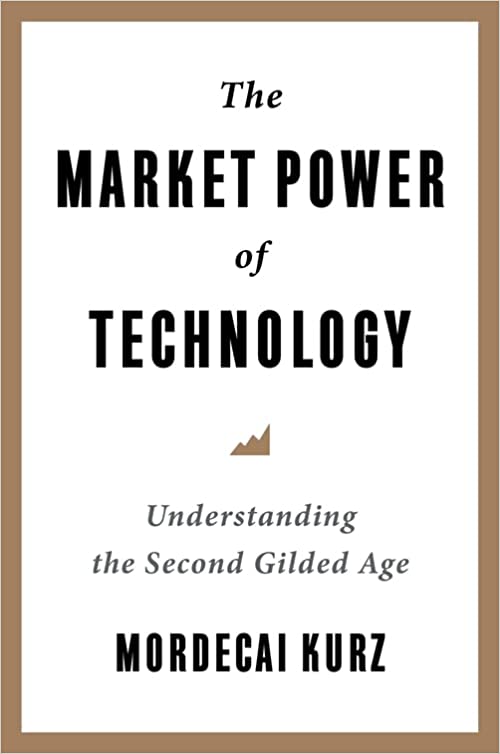Technological innovation is driving the “Second Gilded Age”
 Peter Josty is Executive Director of the Centre for Innovation Studies in Calgary.
Peter Josty is Executive Director of the Centre for Innovation Studies in Calgary.
The market value of the seven largest technology companies in the U.S. is $12 trillion, more than four times the total value of shares traded on the Toronto Stock Exchange.
These companies clearly have substantial market power, which allows them to raise prices and deter competitors, and this is well recognized by the financial markets.
This is just the tip of the iceberg in a market that has become very concentrated and dominated by monopoly power.
How has this come about? And what are the consequences of this market power for Canadian technology firms?
 A recent and intriguing book, The Market Power of Technology: Understanding the Second Gilded Age by Mordecai Kurz (Columbia University Press), provides a convincing explanation. Kurz is Joan Kenney Professor of Economics Emeritus at Stanford University.
A recent and intriguing book, The Market Power of Technology: Understanding the Second Gilded Age by Mordecai Kurz (Columbia University Press), provides a convincing explanation. Kurz is Joan Kenney Professor of Economics Emeritus at Stanford University.
Innovation leads to market power and monopoly
The innovation process gives rise to increased productivity (the good news) and also increased market power that can ultimately lead to a permanent monopoly or oligopoly (the not so good news). When a new technology emerges, many firms jostle for position to be the first with a marketable product or service. Eventually one pulls ahead and becomes the market leader. The first mover gains several advantages including reputation, customer loyalty, and accumulative private information about customers and suppliers.
Over time, firms with an initial advantage consolidate and expand their market power with a variety of strategies, depending on the situation. These strategies include:
- A patent strategy to build a patent fence or patent pyramid around the core technology.
- Acquiring potential competitors to either use their technology or suppress it.
- Intimidating potential competitors.
- Exploiting scale and network effects. If there are increasing returns to scale the incumbent has a significant advantage.
- Creating an ecosystem of dependence. This creates products or services that only work when connected to the initial innovation.
- Developing a reputation for quality.
- Develop loyalty programs and volume discounts, which are impossible for competitors to match.
- A good physical location can confer an advantage, supporting good contact with customers.
- Asymmetric information. The incumbent knows much more about their customers than a potential competitor.
- Dynamic game reasoning. The incumbent can threaten actions that would destroy a potential competitor.
Technological competition is different from “normal” competition
Innovators creating a monopoly from new technology is not a new phenomenon.
Kurz shows convincingly that a similar dynamic was at play when electricity was developed in the period 1888-1929, and General Electric became the monopoly supplier for decades. He also points to the long-term dominance of technology-based firms like AT&T, DuPont, Johnson and Johnson, Proctor and Gamble, and many others.
According to conventional thinking, a new competitor will come along and displace the dominant firm with a new product or service. However, Kurz makes the point that technological competition is different from normal competition, for the reasons noted above. He uses the term “technological market power” to describe this.
So, the idea that a new competitor will come along with a better product and replace the incumbent does not apply when technological competition is involved.
The downsides of monopoly power
Rising market power results in increasing income and wealth inequality, slower economic growth, and economic power being concentrated in a few hands. Unchecked, this erodes the foundations of democracy and creates political polarization.
Kurz shows that there are two periods in U.S. history where monopoly power reached such extreme levels. The first one (which he calls the First Gilded Age), from 1880-1914, was driven by electricity and the internal combustion engine.
The second period is now, (the Second Gilded Age), which started in the 1980s and is driven by information technology.
The economic and political environment is surprisingly similar in the two periods – a stream of innovations driven by new technologies, coupled with a laissez faire economic policy including limited enforcement of anti-trust laws, and a belief that free enterprise without government interference was the natural order of things. (Think Milton Friedman).
In the middle of the 20th century, monopoly power (as well as income inequality) decreased significantly, driven by public discontent with the monopolistic practices. Changes included the stricter enforcement of anti-trust laws, higher income taxes, the rise of the labour movement and legislation to support it, and the formation of the Interstate Commerce Commission in the U.S. to prevent collusion among railways.
The election of Ronald Reagan signaled another change in policy that reduced income tax rates, reduced enforcement of anti-trust laws, and reduced government’s role in the economy. These changes were the origin of the Second Gilded Age that we are currently living through.
Consequences for Canadian technology firms
Technological market power makes it extremely difficult for a Canadian tech startup firm to contribute to the Canadian economy.
If they develop a technology that might compete with Apple, for example, they face two main choices: Compete directly with Apple, or sell out to Apple.
Competing with a $3-trillion colossus with formidable defences is a kamikaze strategy, so they almost always sell out to the dominant firm.
In the last six years Apple has acquired more than 100 companies. They are not alone – Amazon spent $45 billion acquiring 98 companies.
This situation is very beneficial for the founders and the funders, often venture capitalists, who gain significant wealth. But it’s not that good for the Canadian economy, as the firm is absorbed into Apple and loses its Canadian identity. A research centre may remain in Canada as a consolation prize.
There is sometimes a third option – to partner with a big firm or become part of its supply chain. That was the case with Pfizer and Germany-headquartered BioNTech to develop and distribute the COVID 19 vaccine. Perhaps the fact that BioNTech is owned by two billionaires explains why it was not an outright acquisition.
The rare exception is if a Canadian tech firm identifies an opportunity in a totally new market that does not compete with an established player. This was the case with Nortel Networks, Research in Motion and Shopify, but these are only a tiny fraction of all tech startups in Canada.
Nortel Networks, one of Canada’s biggest-ever companies, ultimately declared bankruptcy and sold off large portions of their assets and thousands of patent applications to other companies.
Research in Motion, which developed the BlackBerry phone and was once Canada’s most valuable company, lost the smart phone race to Apple’s touchscreen iPhone.
Conclusion
Kurz makes a convincing case that technological innovation inevitably leads to monopolies or oligopolies unless curbed by strong government policies. Monopoly power is sustained by a variety of strategies, of which protection of intellectual property is only one part.
The monopolies have significant negative effects that include increasing inequality and slowing economic growth. This makes it virtually impossible for Canadian tech firms to grow to a large size without being acquired by a monopolist. There are rare exceptions.
The implications of Kurz’s analysis for policy supporting Canadian tech firms needs to be better understood.
R$
Events For Leaders in
Science, Tech, Innovation, and Policy
Discuss and learn from those in the know at our virtual and in-person events.
See Upcoming Events
You have 0 free articles remaining.
Don't miss out - start your free trial today.
Start your FREE trial Already a member? Log in
By using this website, you agree to our use of cookies. We use cookies to provide you with a great experience and to help our website run effectively in accordance with our Privacy Policy and Terms of Service.




.png)